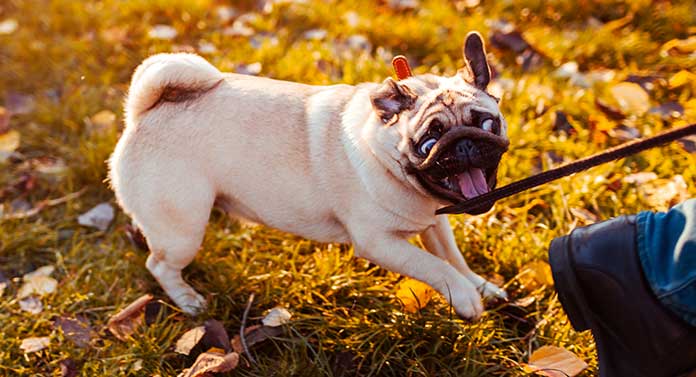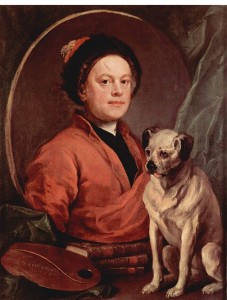Your Pug is a toy breed of dog. They have a cute compact body, happy grin and calm personality. Pug dogs’ characteristics include a striking, flattened, almost human-like face and huge eyes. This is the most defining feature of the breed, but also the reason they are not healthy dogs. Your Pug will have brachycephaly. As they grow your dog will experience trouble breathing, regulating their temperature, eating, digesting their dinner, and just generally doing stuff dogs should be built to do. This is the reason they will make funny noises like snoring and snorting. The Pug also have stenotic nares, slow metabolisms, elongated palates and dental overcrowding that make life very uncomfortable.
Contents
- How were Pugs bred and why have they changed shape?
- Pug health guide – low energy dogs?
- Is your Pug friendly?
- Coats, fur, grooming and shedding
- Pug adoption and buying guide
The emphasis on features over function by big animal clubs and societies has given the Pug a really raw deal. The modern Pug puppy has a big head, bug eyes and a flat face. Their ears are dropped and their tail is tightly curled. This is a dog with a wrinkled expression and underbite that makes them appear pensive, along with that characteristic swaying walk. But all of these features are a long way from your Pug’s Chinese ancestors, and these deviations aren’t a good thing for the Pug breed.
Your Pug’s Ancestors?
The Pug is a fairly ancient breed thought to be of oriental origin. They were first recognized by the American Kennel Club in 1865 but were being imported from China as early as the 16th century.
Were They Bred to Fight Lions?
Sadly, the adorable image of the Pug hunting lions is just not real. Pugs have always been bred as companion dogs. They don’t have any history as working or service dogs. This myth probably came about because many people believe the Bulldog’s face was flat to allow them to wrestle big beasts. But that’s not the case for the Pug.
Famous Pug owners
The passion for the Pug in celebrity circles is nothing new. Pugs were specifically bred to be companions rather than for any practical purpose. And were popular with royalty and other historical celebrities.
Prince William of Orange credited his Pug Pompey with saving his life after the dog alerted him to the approach of the Spaniards. And Josephine Bonaparte reputedly owned a Pug named Fortune.
Queen Victoria owned several Pugs, as did famous English Painter William Hogarth. The early Pug was rather different in appearance than today’s, though. Have a look at the ancient pug pictures of William Hogarth and his Pug below.
What Did Pugs Originally Look Like?
The Pug above was painted in 1745. You can see clearly in art how Pugs used to look. The Pug pictured has quite a substantial muzzle.
The extreme facial shortening we see today has been achieved by selective breeding over the last hundred years or so. And the modern pug looks rather different, as you can see from the profile of the puppy at the top of the page.
Why do They Have Short Snouts?
Your Pug’s family has been selectively breed for flatter and flatter faces. Not to mention for the characteristic ‘screw’ tail that the Pug shares with several other brachycephalic breeds.

What Should Your Pug Look Like?
In an ideal world, your Pug should look like their ancient ancestors. A slightly shorter snout than the average dog, and a little bit of a squatter body, but nothing to write home about. Your puppy should be a healthy young dog, who can function just as well as their longer nosed cousins. And feels well enough to express that natural Pug personality!
Coats and the Weather
Your puppy has a black or fawn coat with a dark muzzle. Your Pug’s coat should be short and glossy, made up of fine hairs. It shouldn’t be coarse or woolly. Although they have an easy to keep coat, they do shed.
Your Pug has a double coat, which means that although it’s fine furred there are two separate layers. This coat type is prone to shedding, and means that they are not classed as hypoallergenic or good for allergy sufferers.
Despite their thick double coat, your Pug does feel the cold. That’s why it isn’t unusual for you to see Pug in a coat wandering around the dog park on freezing days. Just be sure not to use it when it’s warm out, due to the risk of overheating.

Pug Size
As memember of a small breed, your Pug won’t grow much more than 30 cm at the shoulder and shouldn’t weigh more than 18 pounds. Normal Pug weight is actually higher than it should be. That’s because we all have a mental image of a fat Pug being the norm.
These dogs are compact and sturdy. Their bodies are quite hard. Your Pug’s head should be large but not apple-shaped. The breed standard describes their structure as ‘multum in parvo’ which means ‘a great deal in a small space’!
When Do They Stop Growing?
Your Pug puppy will become an adult at around 18 months of age. They will reach their final height at this point, although they’ll probably fill out a little as they go. Their final adult Pug weight will settle around 2 years old.
A 3 year old, 4 year old or 5 year old full grown Pug should not gain any weight from their second birthday onwards. Unless they were underweight at that point. A giant Pug is rarely a healthy or happy one.
Your Pug’s Personality
Generally charming and affectionate, your Pug will be your loyal companion, and have a kind and docile temperament. Hard to fault in terms of personality, they have a delightful nature.
Pug body language is incredibly chilled out and relaxed. They sleep in unusual positions, but this is because it makes it easier for them to breathe, rather than being a sign of their easygoing disposition.
Your Pug will love your family and friendless regardless of their age, and be desperate to spend all their time together.
Do Pugs Like to be Held?
Your Pug will usually accept being held, but that doesn’t mean they actively enjoy it. They will tolerate it because they love you, but unless your Pug is trying to climb into your arms assuming he’s happier with four paws on the floor.
Yours hugs are also warm and constricting, which isn’t ideal for a dog that gets too hot quickly and has obstructions in their airways.
Energetic Dreams
In general the Pug activity level is very low when compared with other breeds of dog. They make a lively addition to a household, but only as long as they are kept cool and not over exercised.
Your Pug will be playful when they have the energy to be. They love games, especially training games and tug of war. Unfortunately, because these dogs suffer quite badly from breathing problems, there are some things you need to consider when it comes to exercise.
The Pug’s face shape restricts your dog’s flow of oxygen. Therefore, exercising is very difficult for them. As well as extreme intolerance to exercise, they are also prone to overheating, which limits the amount of exercise they can do. Typical Pug dog activities include following you around, chewing their favorite toys and sleeping in odd positions.
Is the Pug Easy to Train?
Your Pug might be small, but his brains are mighty! This is a clever little dog that is quick to learn as long as you use positive methods. Although your Pug cannot exert much energy, he will be responsive to training as long as it’s motivating.
Health Problems as a Result of the Pug’s Evolution?
The Pug’s background means they are unfortunately not healthy dogs. In fact, some of the very aspects of the Pug which people find so appealing are actually indicators of serious underlying issues.
Overheating in the Pug Dog Breed
Overheating is the first of several problems you and your Pug will have to face. And it’s a serious concern, which you will need to consider if you decide to buy your Pug puppy. The muzzle of a healthy dog is long in proportion to it’s skull for a reason. It has two very important roles.
The muzzle houses the complex system of ‘turbinates’ which bestow upon dogs the amazing ability to smell tiny traces of substances completely undetectable to man. More importantly, this muzzle provides the dog with an extremely efficient cooling system.
Removing the muzzle from a dog seriously impairs that dog’s ability to regulate his own body temperature. Which means that your Pug can rapidly overheat in warm conditions. That classic happy Pug face is actually a result of them gasping for air.
Stopping Your Pug From Overheating
Ensure your Pug is never over exercised, or allowed to become too hot. Avoid going for walks in the hot weather, and make sure that you bring some water and have access to shade whenever you take him out.
Never leave your Pug alone in the car on a warm day, the usual risk of overheating in cars which normal dog owners work to avoid is increased considerably with your Pug.
Be constantly aware of the risks of your Pug puppy overheating and you should be able to counter its potentially life threatening effects. However, the problems don’t end there. The shortening of the Pug’s muzzle has an even more serious impact on his airways.
Breathing Problems
One of the things people find charming about these dogs is the endearing noises that they make, including a propensity to snore like a train! However, the cause of this noise is sadly anything but adorable.
When we were busy breeding Pugs with shorter facial bones, we sadly failed to reduce the soft tissues of the Pug’s face in proportion to his new smaller muzzle. This left the breed with a lot of spare flesh. Both inside and outside of his mouth.
On the outside this tissue forms deep skin folds, which can cause problems too, but it is the inside of the breed’s mouth we are concerned with here. Inside the pug’s mouth, his soft palate has nowhere to go except into his airway. And this breed often have severely compromised respiratory systems. In more ways than one.
These problems together are termed brachycephalic airway syndrome.
There are surgical options which can help your Pug to breathe more easily in the long term, but considering whether to bring a puppy home who you know will be constantly short of breath is a decision only you can make.
It’s important that you read this information if you are considering buying a Pug puppy as brachycephalic airway syndrome is a significant risk and it will affect your wallet as much as it affects your heart.
Pug Eye Problems
The Pug has abnormally shallow eye sockets. This is related to the shape of the breed’s skull, and happens in other brachycephalic breeds too.
Shallow sockets means protruding eyes. And protruding eyes get scraped and scratched a lot more than they should. They are also prone to ulcers and infections because the dog’s eyelids struggle to close properly over an eye that is sticking out further than it should.
You can help your puppy to reduce these risks by being vigilant with their eye health. Inspect them every day for signs of discomfort, including rubbing, redness and discharge.
Screw Tails
You probably know that the Pug has a cute little corkscrew tail that curls over his bottom. It looks very sweet, but the screw tail can be trouble for these dogs and their owners. The feature that makes the tail lie in a spiral, instead of hanging down behind the dog, is a result of a deformity of the tail bones.
A corkscrew tail is caused by an unusual bone shape which forces the spine to form a spiral. It can cause very painful and severe neurological problems if the deformity affects more than just the tail, and occurs higher up the spine.
Screw tails can also be hard for your pup to keep clean. Your Pug’s tail must be inspected and cleaned daily, wiping off any grime that may have got caught up there. This will reduce the risk of him picking up an infection or getting too grubby.
Dental Problems
The pug has just as many teeth as nature intended. Unfortunately he has nowhere to put them. This is a common problem to several Toy dog breeds and by no means exclusive to the Pug.
The number of teeth in your Pug’s mouth can cause overcrowding. The close proximity of the teeth means that food is more likely to get caught between them, leading to gum disease and tooth decay. Which in turn can cause problems eating.
Other Health Problems
It is worth bearing in mind that although all dogs have health problems of some kind or another, these structural ones are pretty serious and must be taken into account when you are deciding which breed to adopt into your family. They also suffer from other diseases, just like any other pedigree dog. These include
- Pug dog encephalitis
- Hip dysplasia
- Aortic Stenosis – a heart problem
- Leg-Perthes disease – a painful leg bone disease
- Atrial septal defect – a heart problem
- Alopecia (hair loss)
What is important, is that these conditions, some of which occur in other breeds too, are in addition to the 5 structural problems listed above. Those problems are specifically associated with the structure of the dog. A structure that is deliberately selected for and built into the breed standard.
Are Pugs in Pain?
It is likely that most Pugs experience discomfort in their lives more than the average dog. Their issues with temperature control and breathing are very common and make doing normal doggy things more of a challenge. Their eye and dental problems can often be painful too.
If you are worried your Pug is in pain, please don’t hesitate to go and visit your veterinarian.
Lifespan and Life Expectancy
Despite the wide range of issues that they’re faced with, their life span is fairly average. This study of the mortality rates of purebred dogs found that your Pug, on average, is likely to live until they are 11 years old.
A Healthy Pug?
The Pug’s health is improved by outcrossing. There are now breeders specializing in retro Pugs, more like the old Pug breed.
Breeders prioritize snout length and slim build over anything else. Hopefully helping to bring this breed one day back to the condition we’d all love to see them in.
The only truly ethical way to buy your Pug puppy is to go to a breeder that prioritises their health, or to adopt an adult Pug from a rescue center.
Where to get your Pug Puppy?
There are a few things to keep in mind when you’re looking for your new furry friend. Firstly, it’s important to avoid pet stores and puppy mills. Puppy mills are places where people breed dogs en masse to sell them for profit. The dogs in these farms are usually not treated well. This goes for the mothers as well as the pups. The reason pet stores should be avoided is that they tend to source their dogs from puppy mills.
The right place to get a baby Pug dog is from a retro Pug breeder. Or possibly one that breeds Pug mixes. Although cross breeds are less predictable, as long as the breed it’s mixed with has a full snout the puppy is likely to be healthier than the Pug parent.
It is possible, with a careful breeding program, using only dogs with straighter tails, longer muzzles and better set eyes, that over generations you could potentially claw back a healthy structure for this popular breed of dog. But this is probably not a reality. Particularly as some breeders do not recognize that they created a problem.
There are two realistic ways to help these dogs become healthier. The first is to outcross them with a more structurally sound breed or breeds. Allowing them to have a healthier structure but retain some of their charm and delightful character.
The other option is for people to stop buying them altogether. Which is a sad thought, because of course some of those that love Pugs would hate to see a world without them. And owning one may indeed be rewarding in a number of ways for the owner.
Pug Like Breeds
If you are looking for dogs like Pugs, you are probably hoping for a pup that’s small, portable and relatively easy company. So a more realistic alternative could include:
- Cairn Terrier (14 years)
- Toy poodle (14.6 years)
- Border Terrier (14 years)
- Miniature poodle (13.9 years)
Provided that they come from health tested parents, these breeds all have the benefits of the pet Pug without such worrying health issues.


